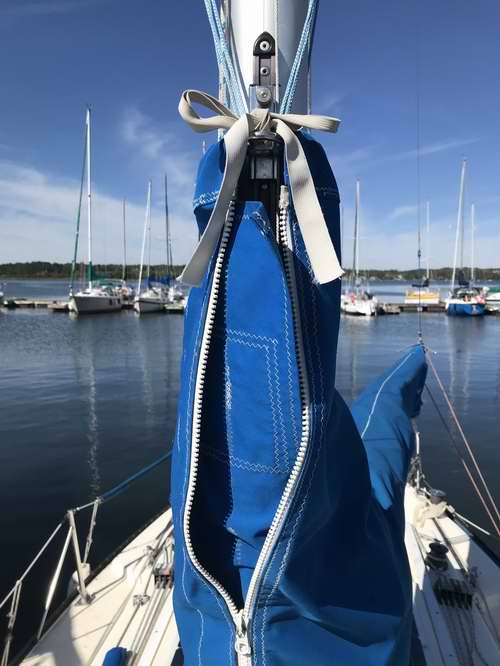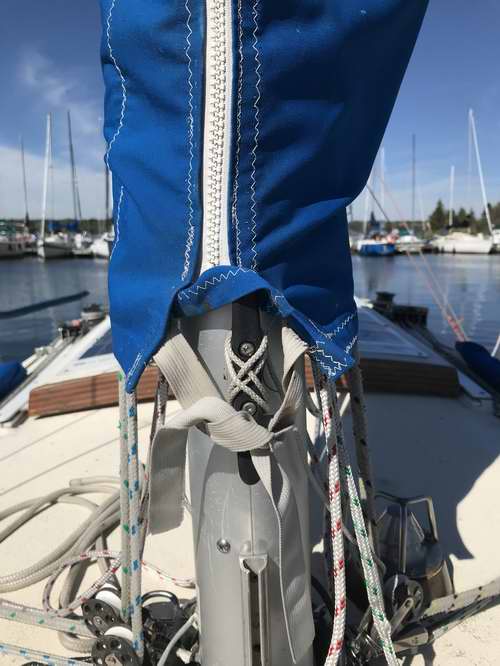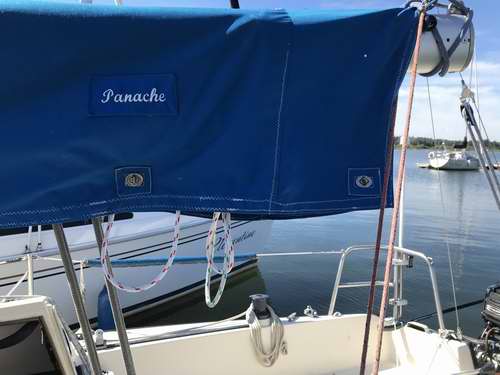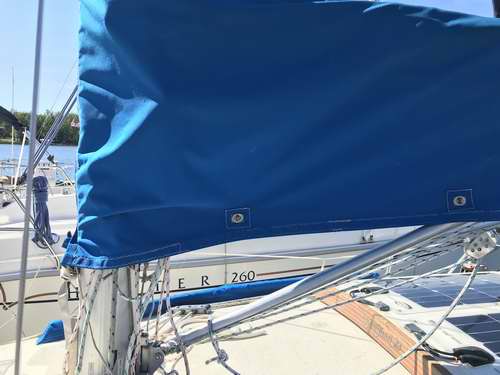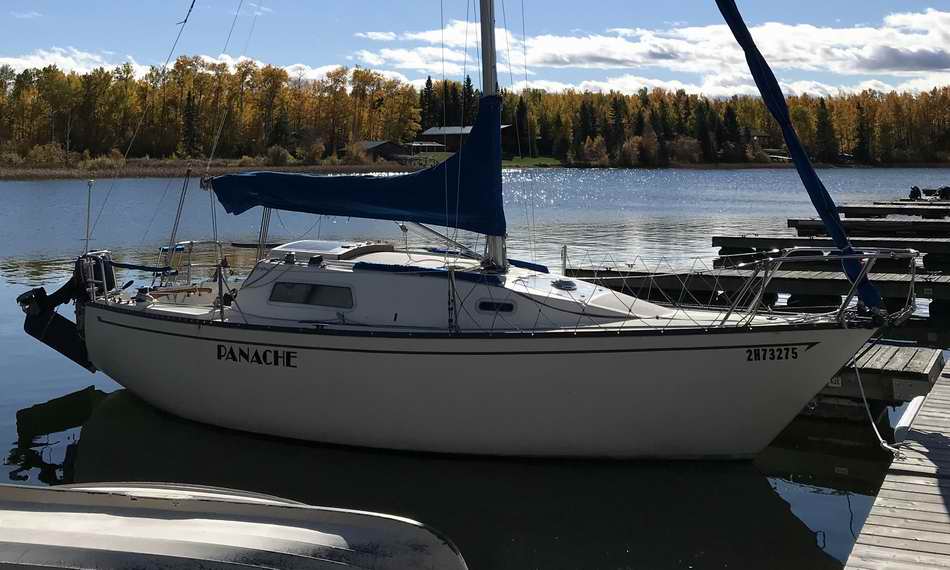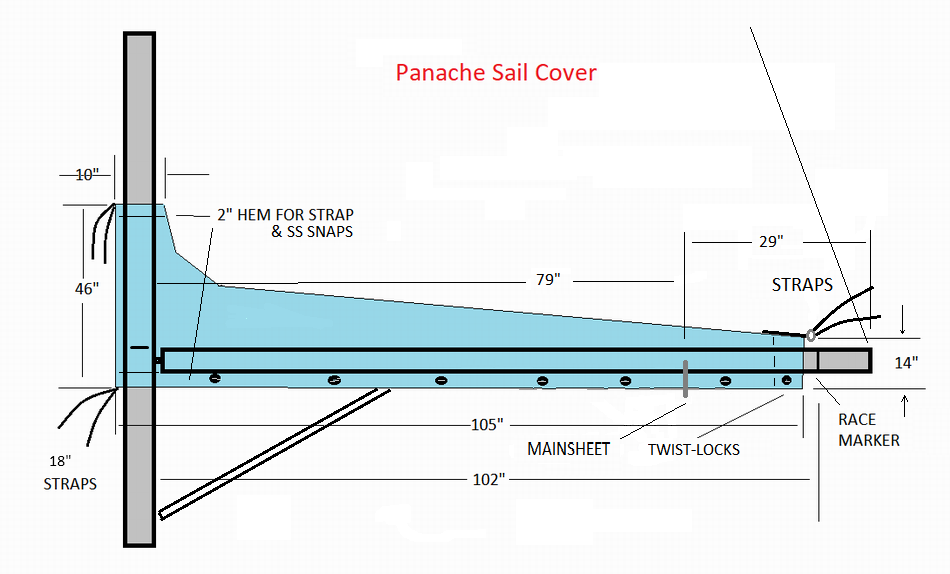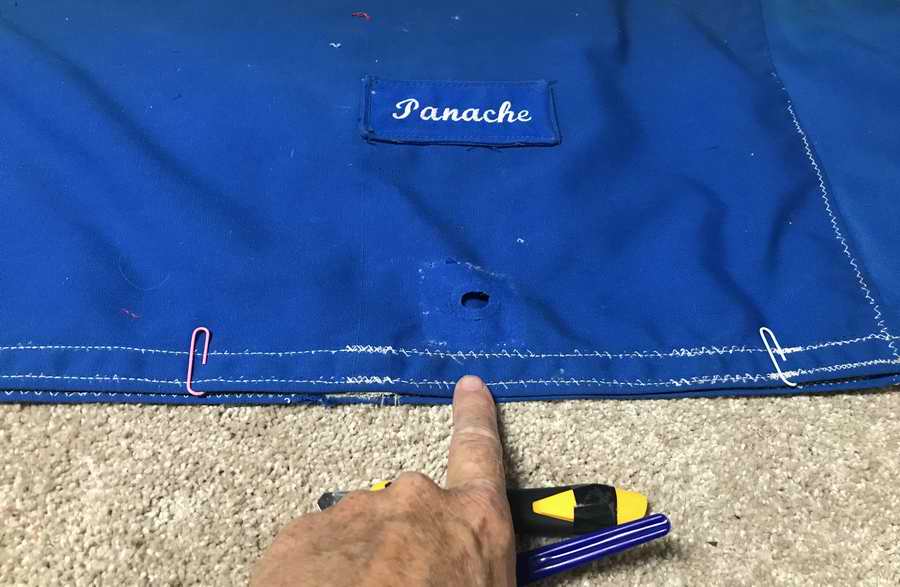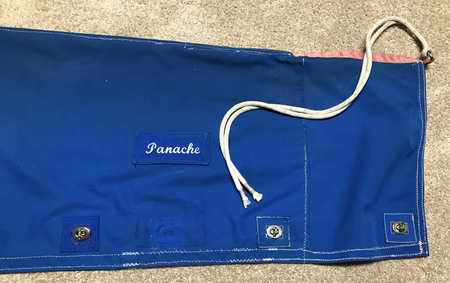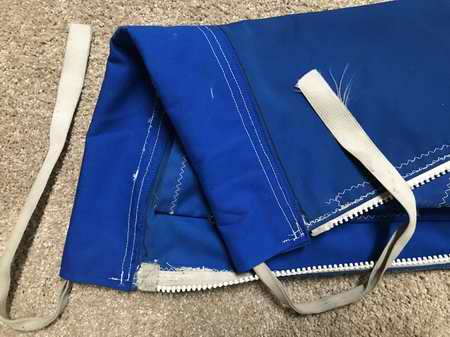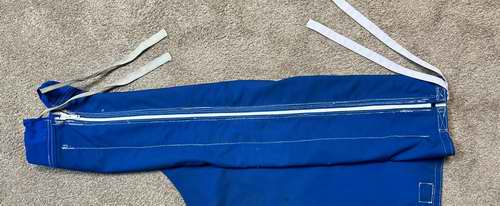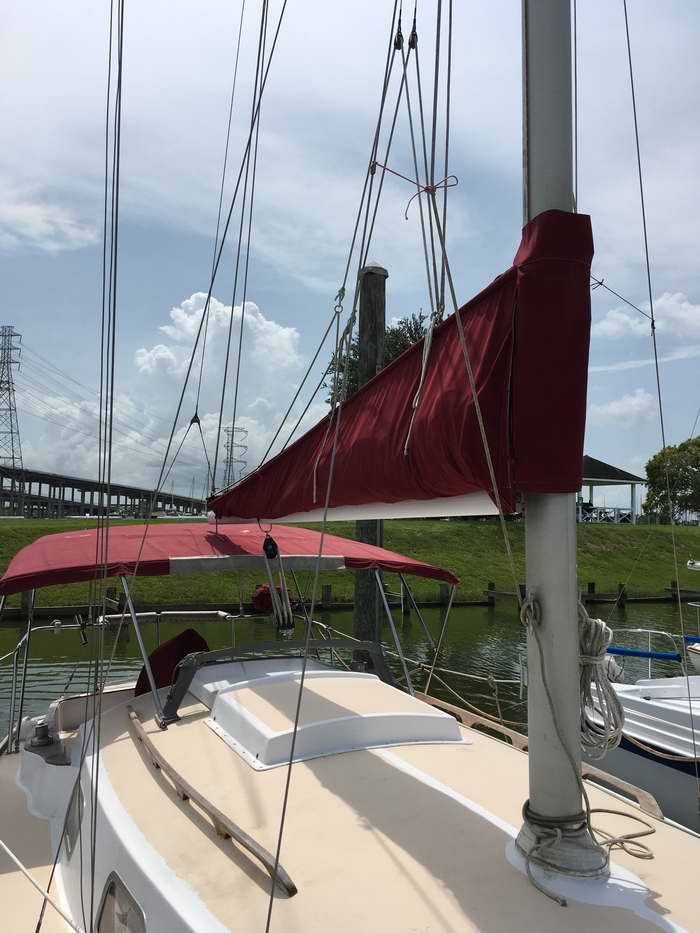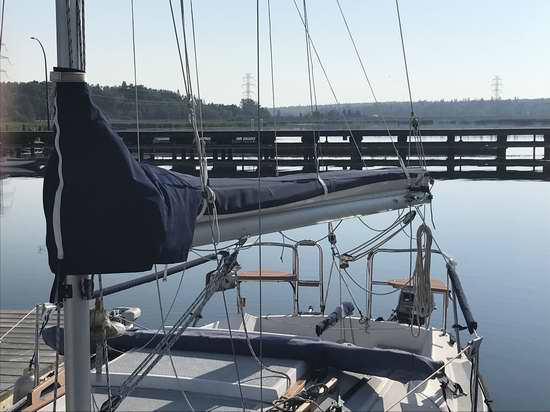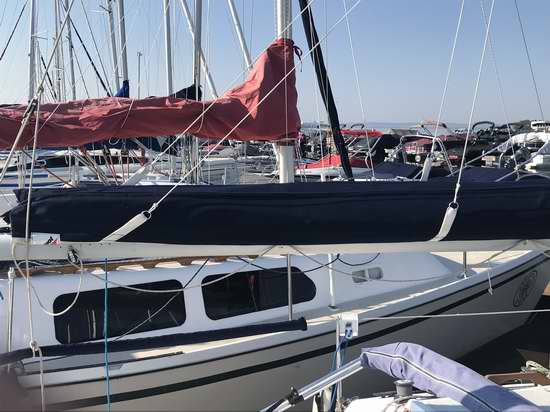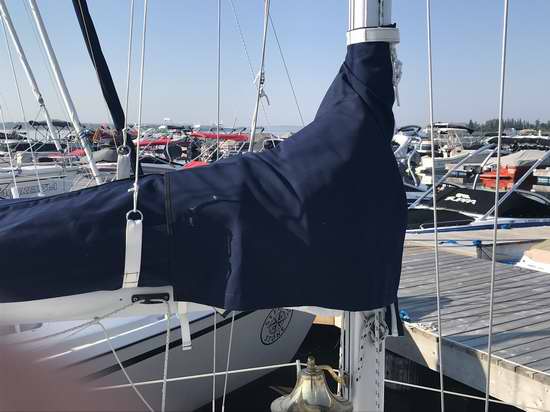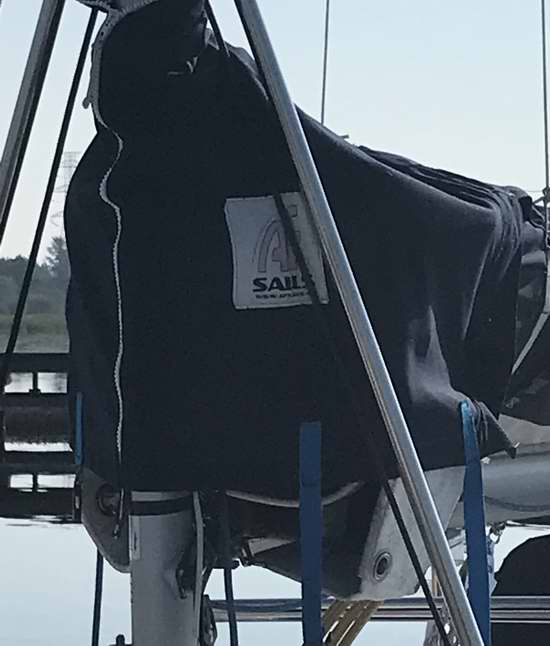| SJ23 Tech Tip F38, (Updated 2025-10-07) Bob Schimmel, Greg Overton. | |||||||||||||||
|
Mainsail Cover - Conventional or Stack Pack. |
|||||||||||||||
CONVENTIONAL COVER - A mainsail cover of Sunbrella prevents UV damage to the sail when it isn't used. It also protects the mainsail from storm damage or bird poop! Many sailors customize the cover with the name of their boat. I much prefer to cover the mainsail than remove the sail from the boom after each float. As the expression goes: "It's definitely the lesser of two evils."
DON THE COVER - I place Panache's rolled up cover over the boom, similar to throwing a saddle on a horse. The top straps are tied around the mast just above the raised spinnaker ring. The internal flap is folded against the front of the mast to protect the anodized finish from the YKK zipper that zips up the front. The bottom straps are tied around the front of the mast to off load the zipper during strong wind. And finally the cover is unrolled towards the end of the boom where the end straps are tied around the boom topping lift to smooth the wrinkles. Finally the SS twist-locks along the bottom are done up. I also set the main sheet to starboard, secured with a line tied to the bottom of the starboard stanchion, pulling against the main sheet to keep the boom from swinging. The boom topping lift keeps the boom just above my head. I board Panache from port just like a horse. DOFF THE COVER - The sail cover is usually rolled up from the forward end to
the aft and stored on the forward berth
with the jib sleeve.
WATER PROOFING (2020)- This mainsail cover has been on Panache's boom since ~1980. I've added a few bits and pieces over the years to improve it, and repaired loose stitches, but not much else. It has also received occasional water proofing with silicon spray but I have never seen the need to wash it, thinking that the rain could do that job. However, after all the years of service I thought it high time to apply a thorough water proof treatment. First I washed it in a laundry tub where to my surprise a lot of coal dust came out. This is from the adjacent open pit coal mine that is now closed. Then I applied NIKWAX TX.DIRECT Spray-on till it saturated the fabric. The advantage of Nikwax over silicon spray is that it can water proof the fabric and retain breathability. I like the fact that the bottle has a pump, negating the propellant that can affect the chemical cocktail creating the water proofing. Nikwax can actually water proof down feathers in a sleeping bag so you stay toasty warm in damp weather. AFT STRAPS (2023) - I finally replaced the short strap on the aft end of the cover with a longer reinforcing strap that also straddles the seam where I extended the cover to full length. The end of this reinforcing strap includes a SS ring to minimize wear from the pull of the tie down strap. TWIST LOCKS (2024) - A SS twist-lock used to be installed right where the mainsheet block rests, making for difficult fastening and an unsightly appearance in the slip. I was reluctant to move it considering the hole that would need to be mended. Now that I have a heavy duty sewing machine I finally moved the twist-lock aft then added another one forward of the mainsheet block and mended the hole. This will allow the cover to rest straight and wrinkle free on the boom. The hem for the top strap around the mast was showing some wear and was replaced. There were also some small tears from snags that needed mending. After a good washing and water proofing, the cover is good to go. Panache's mainsail cover has survived so many storms that I've lost track. This is the single redeeming quality that keeps me from converting it to a stack pack; besides the fact that I don't feel like changing a perfectly good working system! But it is showing signs of degradation so I took the time to do some sewing. Look after yours.
UPDATE NEW ZIPPER (2025) - After 40 some years the zipper at the front finally broke. They just don't make stuff like they used to! I was forced to cut through the zipper fabric to release the sail cover after several bottom teeth broke off. That's frustrating to have to do on the ramp during haul out. Besides replacing the #10 YKK marine grade plastic zipper, I also replaced the short bottom straps for longer ones. The softer material should hold a knot well, creating better support to the bottom of the zipper. The top straps will remain as they are. |
|||||||||||||||
STACK PACK - A stack pack is an improvement on the conventional mainsail cover since all you have to do is pull the zipper along the top to expose the mainsail for hoisting. This speeds deployment and more important, speeds dousing for inclement weather. Its all in keeping with the edict that, "If its quick and easy to do you are more likely to cover the sail quickly to protect it". The covers stay on the side of the boom while sailing so you don't have to pack it away, eliminating another loose item on a berth. Some sailors object to the loose cloth hanging along the boom and have figured out how to pucker the cloth up against the boom, leaving things neatly stored and the mainsail fully exposed for reefing. This clever bit takes some ingenuity. The better designed stack pack can be pulled tight against the boom so it doesn't flop around when sailing. Closing the front was problematic with the early versions as the open sides would catch wind. Experimenting with different techniques solved this problem with designs that wrap around the mast as shown in the example at right. Other designs tuck it against the aft face of the mast. In many cases the portion that goes around the mast is tucked in one side along the boom. On some designs it is removed and stored in the cabin. The lazy jacks typically hold up each side of the stack pack with the assistance of a PVC rod through the hem along the top. This makes catching the mainsail slick and pulling the zipper along the top easy. The downward slope to the end of the boom sheds rain, albeit into the cockpit. But that's what cockpit drains are for. This one looks like a Sailrite design. |
|||||||||||||||
|
|||||||||||||||
|
STACK PACK LINKS -
|
|||||||||||||||
|
Return to Tech Tip Index. . . . . . . . . . . . . . . Have a Question? |
|||||||||||||||
